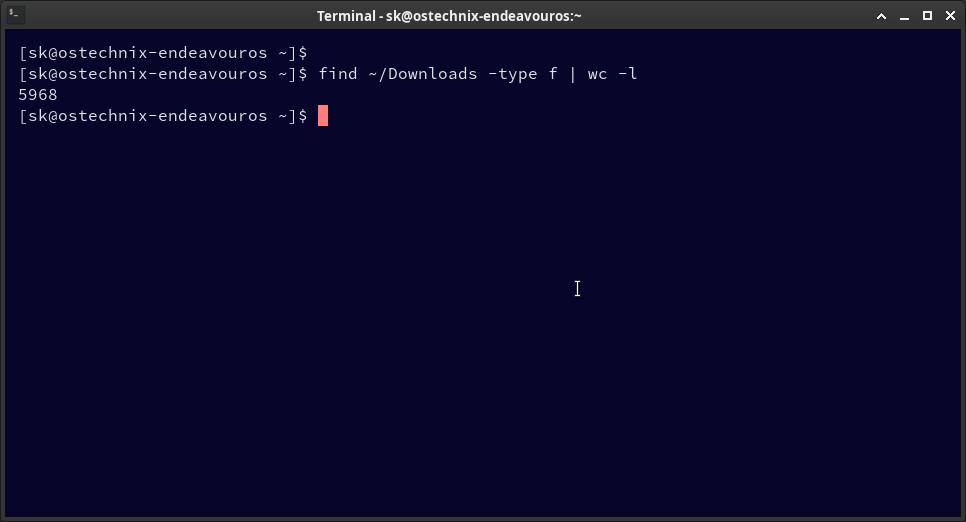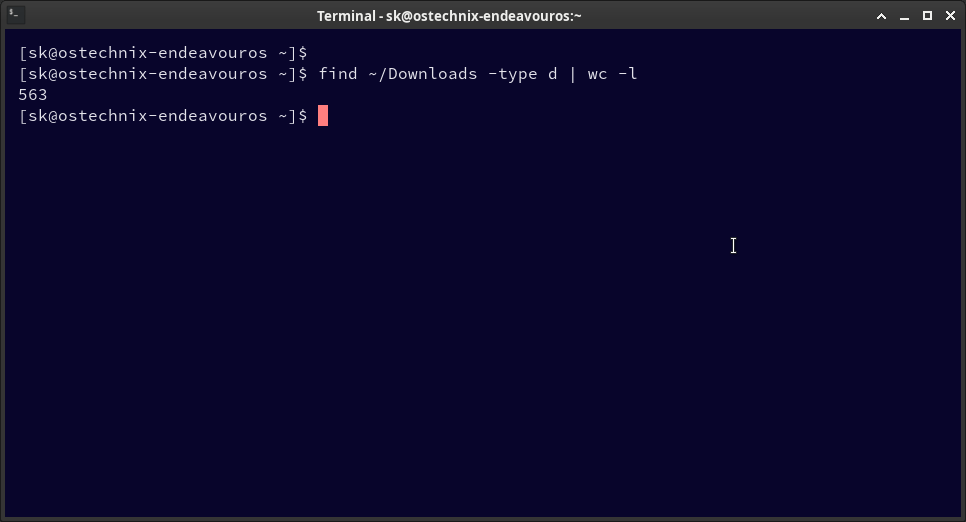How To Count Files And Directories In Linux: A Beginner's Guide
Efficiently Counting Files and Folders in Linux: A Comprehensive Guide
Knowing how to quickly count files and directories in Linux is crucial for system administrators and anyone managing large datasets. This guide demonstrates using simple command-line tools like find, wc, and ls to accurately determine the number of files and folders in Linux and Unix systems.
Table of Contents
- Counting Files in a Directory with
find - Counting Directories with
find - Advanced Counting with
find'smaxdepthandmindepthOptions- Counting Files within a Specific Depth Range
- Counting Directories at a Specific Depth
- Excluding the Top-Level Directory
- Counting Up to a Specific Depth
- Best Practices
- Counting Directories with
ls - Why
findandlsMight Produce Different Counts - Summary
Counting Files in a Directory with find
To count all files within a directory and its subdirectories, use find combined with wc -l:
find /path/to/your/directory -type f | wc -l
-
find /path/to/your/directory: Initiates the search. -
-type f: Specifies that only files should be found (not directories). -
|: Pipes thefindoutput towc -l. -
wc -l: Counts the lines (each line represents a file).
Example:
find ~/Downloads -type f | wc -l 5968
This indicates 5968 files in the Downloads directory.

Counting Directories with find
To count directories, use find with the -type d option:
find /path/to/the/directory -type d | wc -l
-
-type d: Specifies that only directories should be found.
Example:
find ~/Downloads -type d | wc -l 563
This shows 563 directories (including the root directory) within ~/Downloads.

Remember to subtract 1 from the result if you need to exclude the root directory itself.
Advanced Counting with find's maxdepth and mindepth
The maxdepth and mindepth options provide fine-grained control over the search depth.
- Counting Files within a Specific Depth Range: Count files exactly two levels deep:
find /path/to/directory -mindepth 2 -maxdepth 2 -type f | wc -l
- Counting Directories at a Specific Depth: Count directories exactly three levels deep:
find /path/to/directory -mindepth 3 -maxdepth 3 -type d | wc -l
- Excluding the Top-Level Directory: Count files, excluding the top-level directory:
find /path/to/directory -mindepth 1 -type f | wc -l
- Counting Up to a Specific Depth: Count all files up to and including the second level:
find /path/to/directory -maxdepth 2 -type f | wc -l
Best Practices:
- Clearly define your target (files, directories, or both).
- Use
maxdepthandmindepthfor performance optimization in large directories. - Test your command on a small sample before running it on a large directory structure.
Counting Directories with ls
Another approach uses ls, grep, and wc:
ls -lR | grep ^d | wc -l
-
ls -lR: Lists all files and directories recursively with details. -
grep ^d: Filters for lines starting with "d" (directories). -
wc -l: Counts the lines.
This method might yield different results than find due to handling of hidden directories and the root directory.
Why find and ls Might Produce Different Counts
Discrepancies can arise because:
-
Hidden Directories:
findincludes hidden directories by default, whilelstypically doesn't (unless the-aoption is used). -
Root Directory Inclusion:
findincludes the root directory in its count, whilelsmay not, depending on interpretation.
Summary
Using find, ls, and wc, you can efficiently count files and directories in Linux. Understanding the nuances of each command and its options ensures accurate and efficient results, regardless of directory size or complexity. Remember to choose the method best suited to your specific needs and always test your command before applying it to a large directory structure.
The above is the detailed content of How To Count Files And Directories In Linux: A Beginner's Guide. For more information, please follow other related articles on the PHP Chinese website!

Hot AI Tools

Undresser.AI Undress
AI-powered app for creating realistic nude photos

AI Clothes Remover
Online AI tool for removing clothes from photos.

Undress AI Tool
Undress images for free

Clothoff.io
AI clothes remover

AI Hentai Generator
Generate AI Hentai for free.

Hot Article

Hot Tools

Notepad++7.3.1
Easy-to-use and free code editor

SublimeText3 Chinese version
Chinese version, very easy to use

Zend Studio 13.0.1
Powerful PHP integrated development environment

Dreamweaver CS6
Visual web development tools

SublimeText3 Mac version
God-level code editing software (SublimeText3)

Hot Topics
 1379
1379
 52
52
 How To Count Files And Directories In Linux: A Beginner's Guide
Mar 19, 2025 am 10:48 AM
How To Count Files And Directories In Linux: A Beginner's Guide
Mar 19, 2025 am 10:48 AM
Efficiently Counting Files and Folders in Linux: A Comprehensive Guide Knowing how to quickly count files and directories in Linux is crucial for system administrators and anyone managing large datasets. This guide demonstrates using simple command-l
 How To Add A User To Multiple Groups In Linux
Mar 18, 2025 am 11:44 AM
How To Add A User To Multiple Groups In Linux
Mar 18, 2025 am 11:44 AM
Efficiently managing user accounts and group memberships is crucial for Linux/Unix system administration. This ensures proper resource and data access control. This tutorial details how to add a user to multiple groups in Linux and Unix systems. We
 How To List Or Check All Installed Linux Kernels From Commandline
Mar 23, 2025 am 10:43 AM
How To List Or Check All Installed Linux Kernels From Commandline
Mar 23, 2025 am 10:43 AM
Linux Kernel is the core component of a GNU/Linux operating system. Developed by Linus Torvalds in 1991, it is a free, open-source, monolithic, modular, and multitasking Unix-like kernel. In Linux, it is possible to install multiple kernels on a sing
 How To Easily Configure Flatpak Apps Permissions With Flatseal
Mar 22, 2025 am 09:21 AM
How To Easily Configure Flatpak Apps Permissions With Flatseal
Mar 22, 2025 am 09:21 AM
Flatpak application permission management tool: Flatseal User Guide Flatpak is a tool designed to simplify Linux software distribution and use. It safely encapsulates applications in a virtual sandbox, allowing users to run applications without root permissions without affecting system security. Because Flatpak applications are located in this sandbox environment, they must request permissions to access other parts of the operating system, hardware devices (such as Bluetooth, network, etc.) and sockets (such as pulseaudio, ssh-auth, cups, etc.). This guide will guide you on how to easily configure Flatpak with Flatseal on Linux
 How To Type Indian Rupee Symbol In Ubuntu Linux
Mar 22, 2025 am 10:39 AM
How To Type Indian Rupee Symbol In Ubuntu Linux
Mar 22, 2025 am 10:39 AM
This brief guide explains how to type Indian Rupee symbol in Linux operating systems. The other day, I wanted to type "Indian Rupee Symbol (₹)" in a word document. My keyboard has a rupee symbol on it, but I don't know how to type it. After
 What is the Linux best used for?
Apr 03, 2025 am 12:11 AM
What is the Linux best used for?
Apr 03, 2025 am 12:11 AM
Linux is best used as server management, embedded systems and desktop environments. 1) In server management, Linux is used to host websites, databases, and applications, providing stability and reliability. 2) In embedded systems, Linux is widely used in smart home and automotive electronic systems because of its flexibility and stability. 3) In the desktop environment, Linux provides rich applications and efficient performance.
 Linux Kernel 6.14 RC6 Released
Mar 24, 2025 am 10:21 AM
Linux Kernel 6.14 RC6 Released
Mar 24, 2025 am 10:21 AM
Linus Torvalds has released Linux Kernel 6.14 Release Candidate 6 (RC6), reporting no significant issues and keeping the release on track. The most notable change in this update addresses an AMD microcode signing issue, while the rest of the updates
 LocalSend - The Open-Source Airdrop Alternative For Secure File Sharing
Mar 24, 2025 am 09:20 AM
LocalSend - The Open-Source Airdrop Alternative For Secure File Sharing
Mar 24, 2025 am 09:20 AM
If you're familiar with AirDrop, you know it's a popular feature developed by Apple Inc. that enables seamless file transfer between supported Macintosh computers and iOS devices using Wi-Fi and Bluetooth. However, if you're using Linux and missing o





